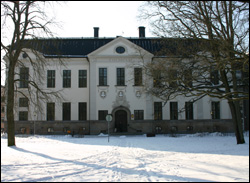Engelska Parken
Engelska parken, Hus 2

Quick facts
- Year Built: 1904
- Architect: Ture Stenberg
- Address: Thunbergsvägen 3 E
- Facility ID: C0059002
- Property Designation: Kåbo 14:3
General information
The original chemical plant located at Carolina Park looks at first glance like a single unit, built at the same time. In fact, the complex consists of two, clearly separated buildings with separate activities.
The oldest part began to be planned in 1901 for the Department of Chemistry and was ready for occupancy in 1904. The building was built in a U-shape with two floors that contained large laboratories, lecture halls, libraries, etc. In the corners around the stairwells, low entrance floors with teachers' quarters, writing rooms and storerooms were placed.
In this building, Theodor Svedberg started his work with physical chemistry. He constructed the ultracentrifuge that separated proteins into their smaller components and this method then became fundamental to modern biochemistry and molecular biology. In 1926 he received the Nobel Prize for his discovery. Svedberg's growing business needed new premises, and in 1931 a new building was completed, specially designed for the new physical-chemical department. The house is being built together with the older building around an enclosed yard.
The new house, which is a four-storey building, will have completely different floor heights. In order to solve the communications between the buildings, the old house was supplemented with a corridor building inside the yard along one wing. In this wing is the large lecture hall and the ultracentrifuge laboratory. Subsequently, a series of additions and rebuilds have taken place.